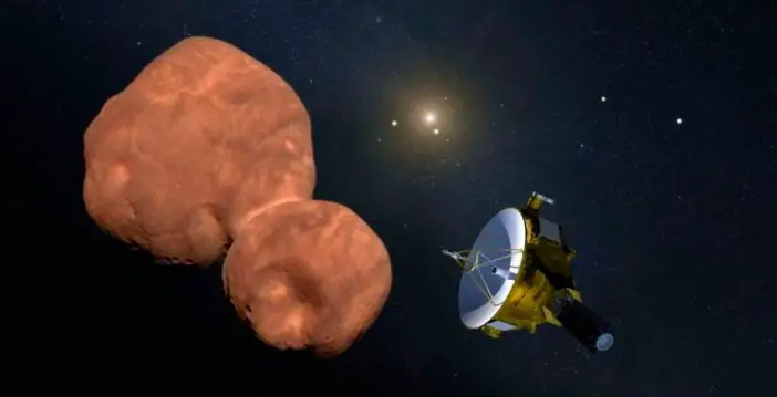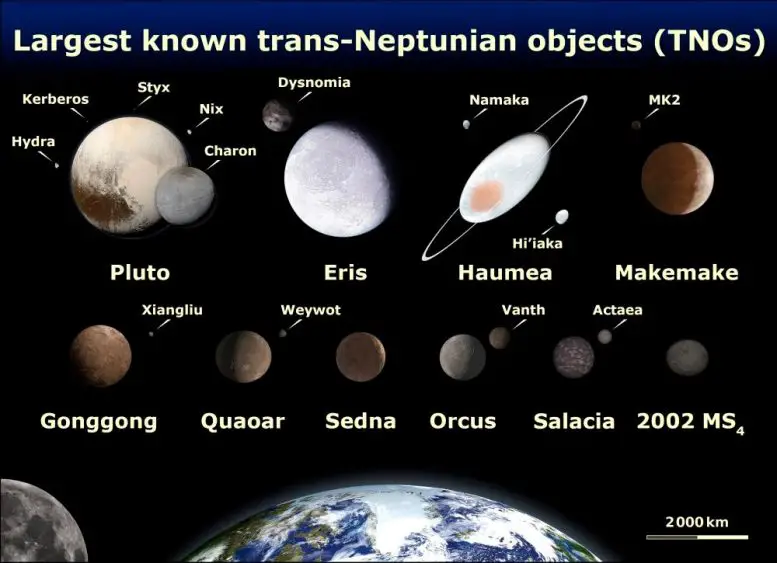Utilizing the James Webb Space Telescope, astronomers have conducted observations of three dwarf planets located within the Kuiper Belt.
In the course of these observations, they made noteworthy discoveries pertaining to the presence of light hydrocarbons and complex molecules. These findings not only contribute to our comprehension of celestial bodies situated in the outer reaches of the Solar System but also underscore the remarkable capabilities of the JWST in advancing space exploration.
The Kuiper Belt, an expansive expanse on the outskirts of our Solar System teeming with icy entities, stands as a veritable treasure trove for scientific exploration. The identification and thorough examination of objects within this region, often referred to as Kuiper Belt Objects (KBOs) or Trans-Neptunian Objects (TNOs), have ushered in a fresh perspective on the historical narrative of our Solar System. The disposition of KBOs serves as a valuable indicator of gravitational dynamics that have played a pivotal role in shaping the Solar System, unveiling a dynamic history characterized by planetary migrations. Since the latter half of the 20th century, scientists have eagerly aspired to acquire closer insights into KBOs, seeking to gain a deeper understanding of their orbital behaviors and compositional attributes.
The James Webb Space Telescope's Outer Solar System Exploration
 One of the primary missions of the James Webb Space Telescope (JWST) is the study of celestial bodies located in the outer reaches of our Solar System. By utilizing data collected through Webb's Near-Infrared Spectrometer (NIRSpec), an international team of astronomers, under the leadership of Professor Joshua Emery from Northern Arizona University, embarked on observations of three dwarf planets within the Kuiper Belt: Sedna, Gonggong, and Quaoar. These observations unveiled intriguing details about their respective orbital characteristics and composition, shedding light on the presence of light hydrocarbons and intricate organic molecules thought to result from methane irradiation.
One of the primary missions of the James Webb Space Telescope (JWST) is the study of celestial bodies located in the outer reaches of our Solar System. By utilizing data collected through Webb's Near-Infrared Spectrometer (NIRSpec), an international team of astronomers, under the leadership of Professor Joshua Emery from Northern Arizona University, embarked on observations of three dwarf planets within the Kuiper Belt: Sedna, Gonggong, and Quaoar. These observations unveiled intriguing details about their respective orbital characteristics and composition, shedding light on the presence of light hydrocarbons and intricate organic molecules thought to result from methane irradiation.
The research was a collaborative effort, involving scientists from diverse institutions, including NASA's Goddard Space Flight Center (GSFC), Institut d'Astrophysique Spatiale (Université Paris-Saclay), the Pinhead Institute, the Florida Space Institute (University of Central Florida), the Lowell Observatory, the Southwest Research Institute (SwRI), the Space Telescope Science Institute (STScI), American University, and Cornell University. Their paper, available as a preprint online, is currently undergoing the review process for potential publication in the journal Icarus.
 Uncovering the Distinctive Compositions of Sedna, Gonggong, and Quaoar
Uncovering the Distinctive Compositions of Sedna, Gonggong, and Quaoar
Emery, in correspondence with Universe Today via email, highlighted the distinct appeal of these celestial bodies to astronomers due to their unique blend of size, orbits, and compositions. Unlike Trans-Neptunian objects like Pluto, Eris, Haumea, and Makemake, which typically preserve volatile ices such as nitrogen and methane on their surfaces,
Sedna, Gonggong, and Quaoar deviated from this conventional pattern. The research team, under Emery's leadership, aimed to investigate whether these three dwarf planets displayed a similar presence of volatile ices on their surfaces.
These findings align with recent studies led by Dr. Will Grundy and Chris Glein, who assessed deuterium/hydrogen (D/H) ratios in methane on Eris and Makemake. Their results indicated that the origin of methane was not primordial but instead linked to internal processes and subsequent delivery to the surface.
Emery further suggested, "We propose that a comparable process might be applicable to Sedna, Gonggong, and Quaoar. Moreover, the distinct spectral characteristics observed in these three larger objects, as unveiled by recent JWST data, imply that Sedna, Gonggong, and Quaoar possess a unique geological history."
Insights from Webb: Revealing the Mysteries of the Outer Solar System
These findings carry profound implications for the study of objects within the Kuiper Belt, Trans-Neptunian Objects (TNOs), and other bodies located in the outer reaches of our Solar System. They offer fresh insights into the formation of objects situated beyond the Frost Line, a demarcation where volatile compounds transition into solid freezing points. In our Solar System, this region corresponds to the Trans-Neptunian area, denoting the nitrogen line, where celestial bodies retain substantial quantities of low-freezing-point volatiles like nitrogen, methane, and ammonia. As Emery pointed out, these discoveries also shed light on the evolutionary processes that influence bodies in this specific region.
The primary implication," he noted, may lie in determining the size at which Kuiper Belt Objects become sufficiently warm for internal reprocessing of their primordial ices, potentially leading to differentiation. These spectra can also enhance our comprehension of the irradiation-induced transformations of surface ices in the outer Solar System.Future investigations can further explore volatile stability and the potential presence of atmospheres during various segments of these bodies' orbits."
These findings underscore the exceptional capabilities of the James Webb Space Telescope (JWST), which has consistently proven its worth since commencing operations. They serve as a reminder that, beyond unveiling distant planets, galaxies, and the Universe's large-scale structure, the Webb telescope can also provide valuable insights about our local celestial neighborhood.
Emery expressed his appreciation for JWST's contributions, stating, "The JWST data are exceptional. They have enabled us to obtain spectra in longer wavelengths than ground-based observations, facilitating the detection of these ices. Often, when exploring new wavelength ranges, initial data quality can be limited. JWST not only expanded our observational range but also supplied remarkably high-quality data capable of discerning various surface materials in the outer Solar System."